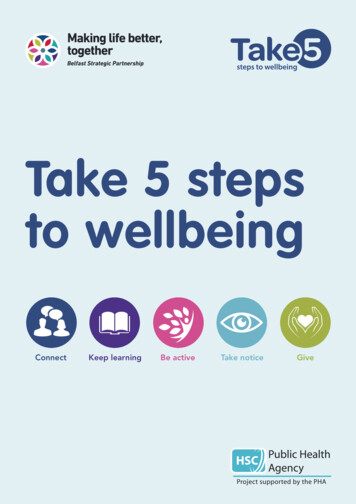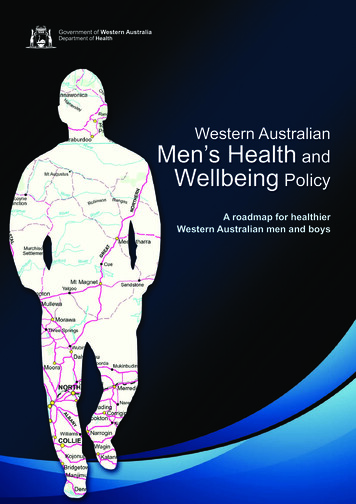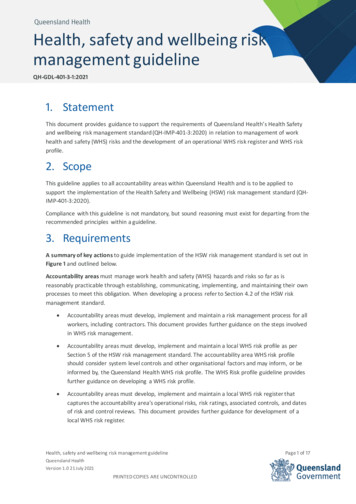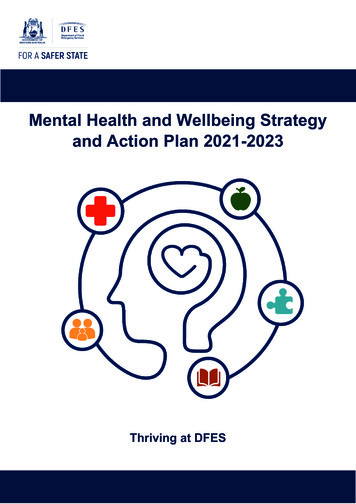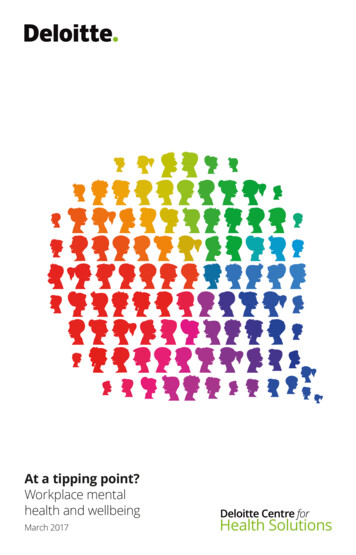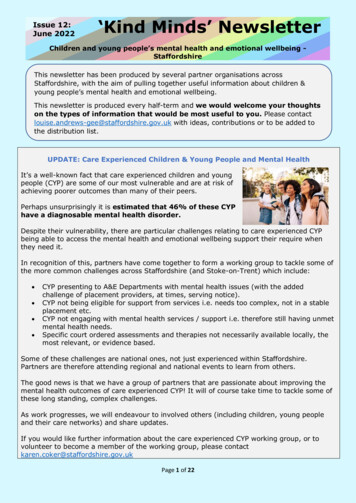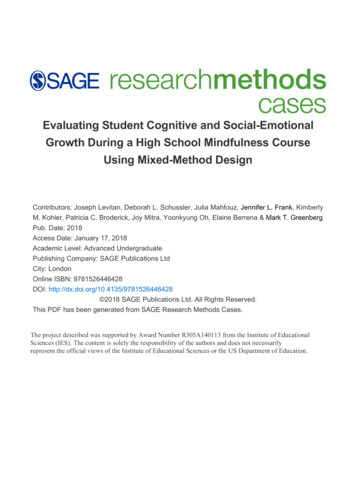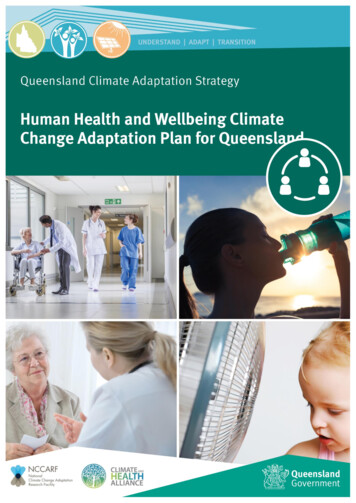
Transcription
This Sector Adaptation Plan was developed by health care, aged care and early childhood education and carestakeholders with the support of the Queensland Government. Sector Adaptation Plans are important componentsof the Queensland Climate Adaptation Strategy, outlining industry-led responses to the challenges presented byclimate change. State of Queensland, 2018.The Queensland Government supports and encourages the dissemination and exchange of its information. Thecopyright in this publication is licensed under a Creative Commons Attribution 3.0 Australia (CC BY) licence.Under this licence you are free, without having to seek our permission, to use this publication in accordance withthe licence terms.You must keep intact the copyright notice and attribute the State of Queensland as the source of the publication.For more information on this licence, visit .enAuthorsFiona Armstrong and Sue Cooke, Climate and Health Alliance (CAHA)David Rissik and Fahim Tonmoy, National Climate Change Adaptation Research Facility (NCCARF)DisclaimerThis document has been prepared with all due diligence and care, based on the best available information at thetime of publication. The department holds no responsibility for any errors or omissions within this document. Anydecisions made by other parties based on this document are solely the responsibility of those parties. Informationcontained in this document is from a number of sources and, as such, does not necessarily represent governmentor departmental policy.AcknowledgementsThis Human Health and Wellbeing Climate Change Adaptation Plan has been developed by, and in partnershipwith, Queensland's health and wellbeing sector. The Department of Environment and Science (DES) would like tothank the National Climate Change Adaptation Research Facility, the Climate and Health Alliance, QueenslandHealth, the Queensland Council of Social Services, NRM Regions Queensland and a range of other industrystakeholders that provided valuable input through participation in the consultation process and reviewing the draftplan. The H-CAP development team would like to thank Jyotishma Rajan, Senior Policy Officer in DES, for hervaluable contribution and guidance throughout the project. We also thank Shakiba Das, Master of Public Healthstudent, Australian Catholic University, for her assistance during the project.ii
ContentsExecutive Summary .1Introduction .3Background .3Scope of the Plan .4Why are early childhood and aged care included? .5How the H-CAP was developed .6Consultation .6Engagement process .6Summary of climate risks for health and wellbeing services .7Existing policy frameworks .9International.9National .9State .10Other enablers of adaptation.10Legal opinion – Board and directors’ duties .10Framework for a National Strategy on Climate, Health and Well-being for Australia .10The Lancet Countdown .11WHO Hospital Safety Index .12Global Green and Healthy Hospitals() .12Current progress towards adaptation .12Case study 1 .13Case study 2 .13Case study 3 .14Queensland stakeholder views .15Theme 1: Impacts of climate change on health and wellbeing .15Physical and mental health impacts .15Ability to provide safe, high-quality service under changing circumstances .16Theme 2: Gaps and barriers to adaptation .17Lack of leadership, policy, regulation and guidance .17Lack of dedicated resources (human and financial) .18Gaps in capacity, knowledge, data and research .18Cross-cutting and cross-sectoral barriers .18Theme 3: Opportunities and co-benefits .18Community resilience, wellbeing and financial co-benefits .19No-regrets, win-win outcomes .19Co-benefits from a healthier natural environment .19Community engagement .19Theme 4: Pathways to respond .20Leadership, policy and governance .20Health Impact Assessment .21iii
Human Health and Wellbeing Climate Change Adaptation Plan for QueenslandRisk assessment and legal responsibility .21Building resilience and adaptive capacity within the system .21Funding and resourcing .21Collaboration across sectors .21Community engagement and education .21Research and data .22Building on the strengths of vulnerable groups .22The Plan.23Vision .23Principles .23Priority Adaptation Measures .231.Leadership and governance .242.Building capacity in the sector and the community.253.Specific public health measures .264.Risk management and legal liability .275.Research, data and evaluation .286.Economics and financing .297.Collaboration across agencies, sectors and stakeholder groups .298.Education and communication .309.Policy, regulation and legislation .3110.Infrastructure, technology and service delivery .32Glossary .34Appendix 1 – List of participants .37Workshops and survey participants .37Interviews .41Aged care .41Early childhood .41Aboriginal and Torres Strait Islander health and wellbeing .41Queensland Health .41NRM Regions Queensland .41Queensland Council of Social Service .41Steering Committee .42Expert Reference Group (reviewers) .42Appendix 2 – Summary of expected impacts of climate change on health in Queensland .43Extreme weather events .43Increasing temperature and heatwaves .43Infectious diseases and vector-borne threats.43Food and water security .43Occupational health impacts .43Mental illness and stress .43iv
Human Health and Wellbeing Climate Change Adaptation Plan for QueenslandAeroallergens and air pollution .43Vulnerable populations .44Social instability, national security and conflict.44References for this appendix .44Appendix 3 – Analysis of survey, workshop, meeting and interview data .46Survey data collection .46Who responded to the survey? .46Workshop data collection .47Who attended the workshops? .47How were the workshops structured? .47Meeting and interview data collection .47Synthesis of data from workshops, survey responses, meetings and interviews with key informants .48Climate change impacts on health and wellbeing in Queensland .48Barriers to adapt to climate change .49Opportunities (co-benefits) from adaptation and mitigation .50What can be done to move adaptation forward? .51Appendix 4 – Frameworks, tools and resources .53v
Human Health and Wellbeing Climate Change Adaptation Plan for QueenslandExecutive SummaryThe Queensland Government committed to implementing the Queensland Climate Adaptation Strategy (Q-CAS) in2017. This Human Health and Wellbeing Climate Change Adaptation Plan (H-CAP) was developed as acomponent of the Q-CAS. The National Climate Change Adaptation Research Facility (NCCARF) and the Climateand Health Alliance (CAHA) worked with key stakeholders in the health and wellbeing sector in Queensland todevelop the H-CAP.The goal of the H-CAP is to support human health and wellbeing services to be innovative and resilient inmanaging the risks associated with a changing climate, and to harness the opportunities provided by responding tothe challenges of climate change. It provides a preliminary climate change adaptation framework and guidance forstakeholders across health care, aged care, and childcare services.This document outlines the process to develop the H-CAP and describes its scope. It provides an overview ofexisting policy, and outlines policy drivers and enablers, and case studies to inspire action. It also summarises theconcerns of stakeholders in Queensland about the health impacts of climate change, in addition to the barriers,opportunities and pathways forward they saw for climate adaptation.The consultation revealed concerns among stakeholders that are consistent with multiple lines of evidence: there isa policy gap in relation to addressing the health impacts of climate change.Health and wellbeing services are faced with climate change adaptation challenges, but lack policy guidance, aswell as capacity and resources to respond. The consultation revealed a strong appetite to build climate resilience inthe sector to ensure service quality and continuity, and to protect the health of the community. There was a clearemphasis on the need for stakeholder engagement and for the establishment of collaborative networks to guideand support action.To help guide efforts towards climate change adaptation among health and wellbeing services in Queensland, thisH-CAP proposes 10 Priority Adaptation Measures, together with a vision and a set of guiding principles. ThePriority Adaptation Measures offer high level guidance for services, policymakers and the community to prioritiseand plan for climate adaptation. They include examples of possible responses at service, system and governmentlevels, informed by stakeholders and existing best practice.The Priority Adaptation Measures are:1.Leadership and governance—empowering leadership at all levels to plan and implement responsible,evidence-based, locally relevant climate change adaptation.2.Building the preparedness and ability of the health and wellbeing services sector and the community torespond to climate threats to health.3.Specific public health measures—evaluating specific vulnerabilities in the population and implementingappropriate measures to reduce avoidable morbidity and mortality.4.Risk management and legal liability—ensuring the operational and strategic plans of all facilities andservices acknowledge and reflect the short-, medium- and long-term risks of climate change to health andwellbeing services.5.Research, data and evaluation—guiding policy and decision-making through well-planned research andclimate-health risk surveillance to build greater understanding of risks, vulnerabilities and effective strategies.6.Economics and financing—ensuring that financing decisions to support climate change related programsand initiatives include assessment of all the relevant health costs and benefits associated with climate change andadaptation.7.Collaboration across agencies, sectors and stakeholder groups—ensuring that government agencies, peakbodies, and industry and professional associations and service providers work together to achieve climate changeadaptation and sustainability goals.1
Human Health and Wellbeing Climate Change Adaptation Plan for Queensland8.Education and communication—developing communication, education and training initiatives that informand build capacity across the health and wellbeing workforce, policymakers and the wider community to respond tothe health impacts of climate change.9.Policy, regulation and legislation—providing policy certainty for services, sectors and industries to guidedecisions and investment for effective climate change adaptation.10.Infrastructure, technology and service delivery—investing in climate-resilient infrastructure, technology andservice design to avoid delayed costs and ensure service integrity.This H-CAP represents the start of an ongoing and iterative journey towards climate change resilience within thehealth and wellbeing sector. The plan will need to be developed further through effective engagement with manymore participants in the health and wellbeing sector, different government departments, and the community ingeneral. Further engagement and additional strategies will need to be incorporated over time.2
Human Health and Wellbeing Climate Change Adaptation Plan for QueenslandIntroductionThe Human Health and Wellbeing Climate Change Adaptation Plan (H-CAP) supports healthcare, aged care andearly childhood education and care services to be innovative and resilient in managing the risks, and to harness theopportunities provided by responding to the challenges of climate change.As a high-level roadmap for adaptation, it aims to facilitate ongoing collaboration and provide direction for climatechange adaptation planning, implementation and engagement. As such, the H-CAP scope does not includedetailed actions for stakeholders. Queensland Government agencies, including Queensland Health, areconcurrently assessing climate change risks to their assets and services.BackgroundThe H-CAP is one of eight sector adaptation plans being developed by the Queensland Government under theQueensland Climate Adaptation Strategy (Q-CAS). The Q-CAS conceptualises four major and interrelated‘pathways’ for Queensland’s adaptation:i)People and Knowledgeii)Local Governments and Regionsiii) Sectors and Systems—where this plan sitsiv) State GovernmentThe Q-CAS identifies four complex issues that cut across all sectors or systems: community and social services,finance and insurance, natural resources, and research and development.Figure 1 illustrates where the H-CAP sits within the four pathways and intersects with the cross-cutting issues.Figure 1: Matrix representation of Q-CAS pathways, eight Sectors and Systems, including the H-CAP, and crosscutting issues3
Human Health and Wellbeing Climate Change Adaptation Plan for QueenslandScope of the PlanFor the purpose of the H-CAP, the human health and wellbeing sector includes health care(1), aged care andchildcare services.The H-CAP was developed with, and targets stakeholders in: health facilities such as hospitals, health services and clinics, and tertiary, primary andpreventative health services for both physical and mental healthsocial sector organisations providing services for, or representing, vulnerable or marginalisedcommunity membersaged care servicesearly childhood services, including kindergartens, preschools and child care, (e.g. communitybased, not-for-profit and private providers of long day care and kindergarten services).These stakeholders are part of Queensland’s biggest industry. The health and wellbeing sector is the nation’slargest industry by employment, providing jobs for 285,000 people in Queensland, and accounting for 13 per centof all jobs in the state(2).The health sector is also one of the most emissions-intensive industries in the state. A recent study estimateshealth care is responsible for 7 per cent of national emissions, or 35.7 million tonnes per annum. The authorsestimate that emissions from health care in Queensland is 21 per cent of the national healthcare total, or around7.5 million tonnes each year(3).Figure 2: Breakdown of total healthcare emissions in Australia, from Malik et al. 20181 As shown in the Q-CAS, ‘health care’ includes health facilities such as hospitals, health services and primaryhealth care.2 Australian Bureau of Statistics 2017, Healthcare and social assistance our largest industry, 001F743B?OpenDocument (accessed 15 May 2018).3 Malik, A, Lenzen, M, McAlister, S and McGain, F 2018, The carbon footprint of Australian health care, The LancetPlanetary Health, 2 (1):e27–e35, and personal communications with the authors.4
Human Health and Wellbeing Climate Change Adaptation Plan for QueenslandThe determinants of health and wellbeing (and illness) arise largely outside the healthcare system (e.g. economic,social, environmental, cultural and technological factors). However, the health sector and those focused oncommunity health and wellbeing are in the frontline in responding to the health impacts of climate change. Thus theH-CAP and its strategies are largely focused on the factors that services involved in delivering health care, agedcare and child care can influence. The scope of the project did not allow for engagement with stakeholders in thewider community, although participants noted the importance of community involvement in future adaptationplanning and action.Further, while mitigation is recognised as an essential ingredient for effective adaptation, the H-CAP focuses onclimate change adaptation. Stakeholders, however, note that many climate change mitigation actions can directlyreduce the burden of ill health, boost community resilience, and lessen poverty and inequity. It is hoped that infurther development of this work, a combined focus on mutually reinforcing mitigation and adaptation can beincorporated(4). This approach is supported by institutions such as the World Health Organization and the WorldBank, as exemplified in this statement from the latter’s recent report on Climate-Smart Healthcare:The health sector has a substantial role to play in both mitigating climate change through theadoption of low-carbon strategies, while also building resilience to climate impact in ways thatplan for environmental change and expanded health threats. Taken together, these effortscomprise a ‘climate-smart’ approach that will help health planners and decision-makers adjustto a new era of climate reality while improving health, environment, and development. JamesClose and Olusoji Adeyi, World BankIt is important to recognise that the H-CAP represents the start of an ongoing and iterative journey. It will need tobe revisited and updated, with further engagement and strategies incorporated over time.Why are early childhood and aged care included?Young children and the elderly represent two of Queensland’s population groups most vulnerable to the negativeimpacts of a changing climate. For example, they are among the first to suffer from the effects of prolonged orextreme heat. Together, the aged care and childcare sectors are large employers with significant infrastructure andfacilities, providing care and support to vulnerable groups, which makes them an important component ofQueensland's health system.The aged care sector particularly has a strong interaction with health service providers. Considering and managingclimate change risks to these groups can have a substantial influence on the health of the broader community.The proportion of older people (65 years and over) in Queensland’s population is increasing. This proportionreached 13 per cent in 2011, and is projected to reach between 19 and 21 per cent by 2036, and between 22 and25 per cent by 2061(5). Elderly people are often more vulnerable to a range of climate change mediated healthimpacts including heat stress, and buildings in aged care facilities are not always well adapted to reduce thermalstress during heatwaves(6).What happens in early childhood shapes health and wellbeing throughout the lifespan, and research shows it alsoaffects the wellbeing of society(7). For our children, despite the many benefits of modern society, the world is a less4 https://www.thelancet.com/climate-and-health?code lancet-site5 Queensland Government 2015, Queensland Government population projections, Queensland GovernmentStatistician's Office, accessed 15 May -
and plan for climate adaptation. They include examples of possible responses at service, system and government levels, informed by stakeholders and existing best practice. The Priority Adaptation Measures are: 1. Leadership and governance—empowering leadership at all levels to plan and implement responsible,
